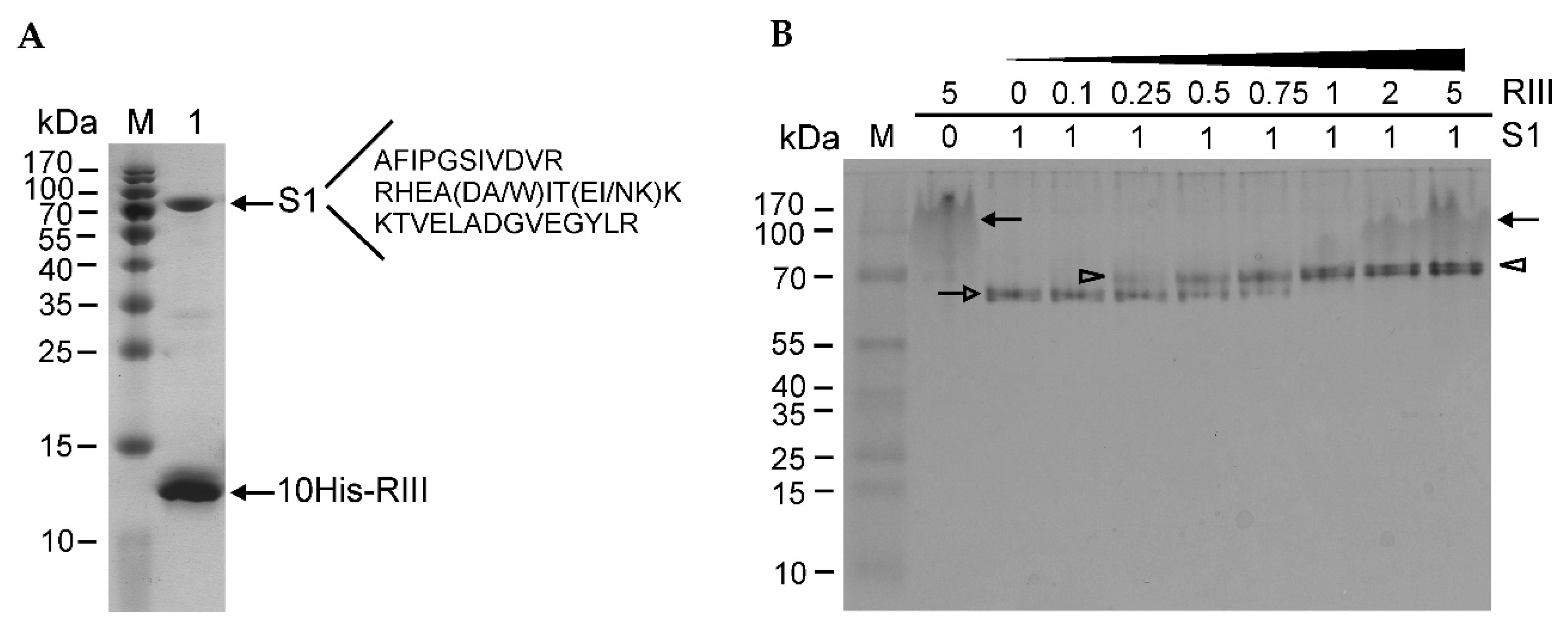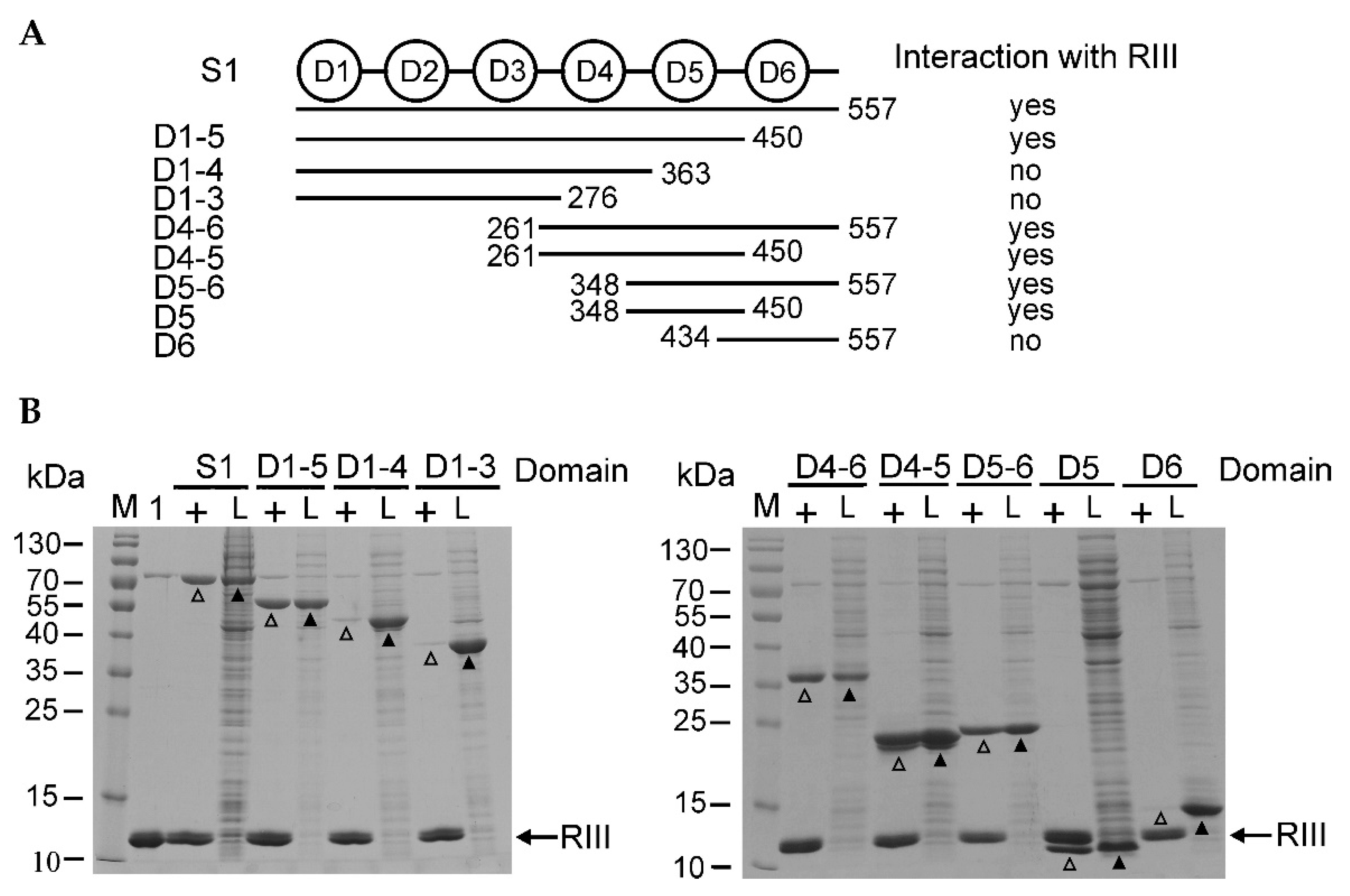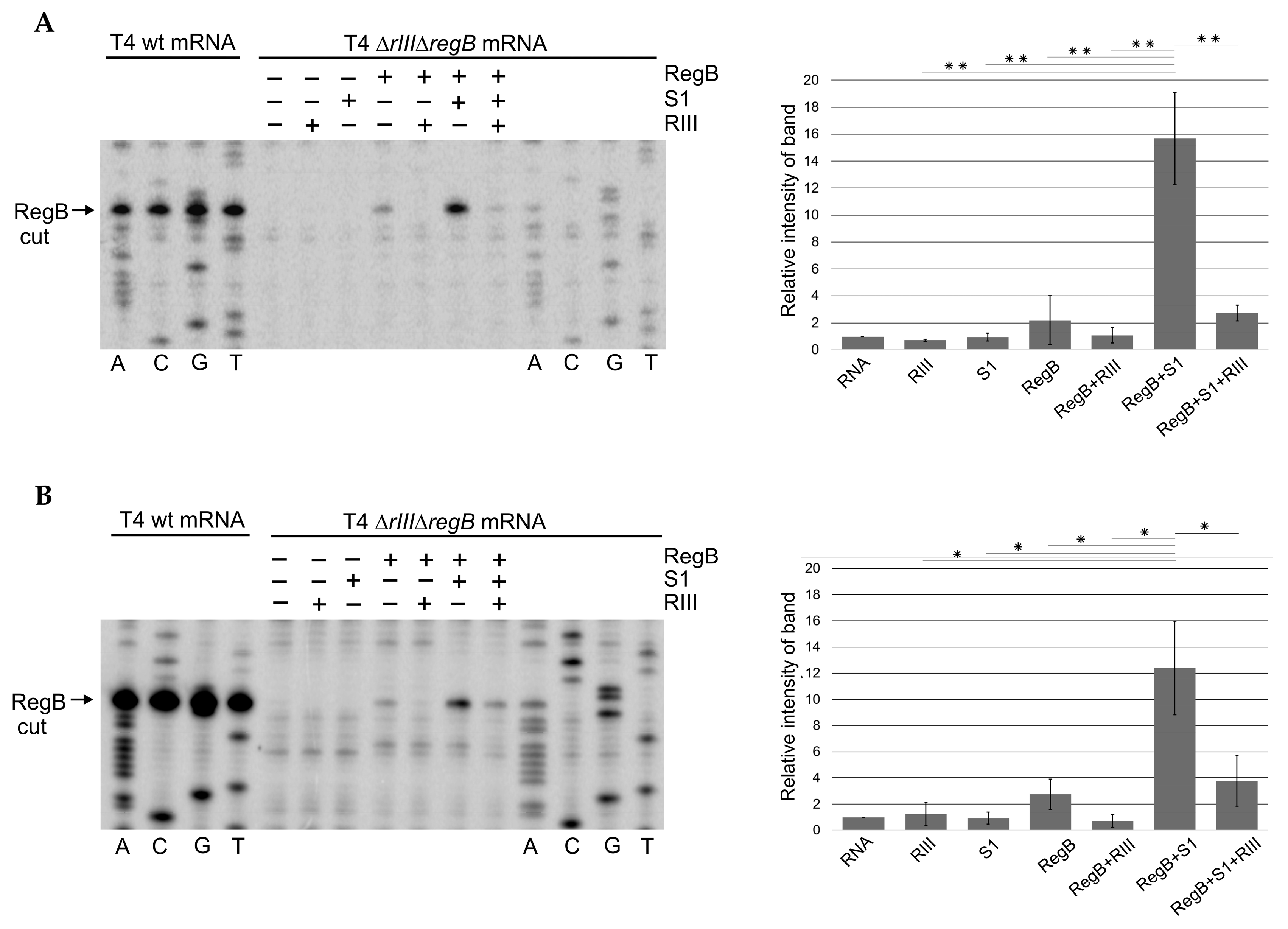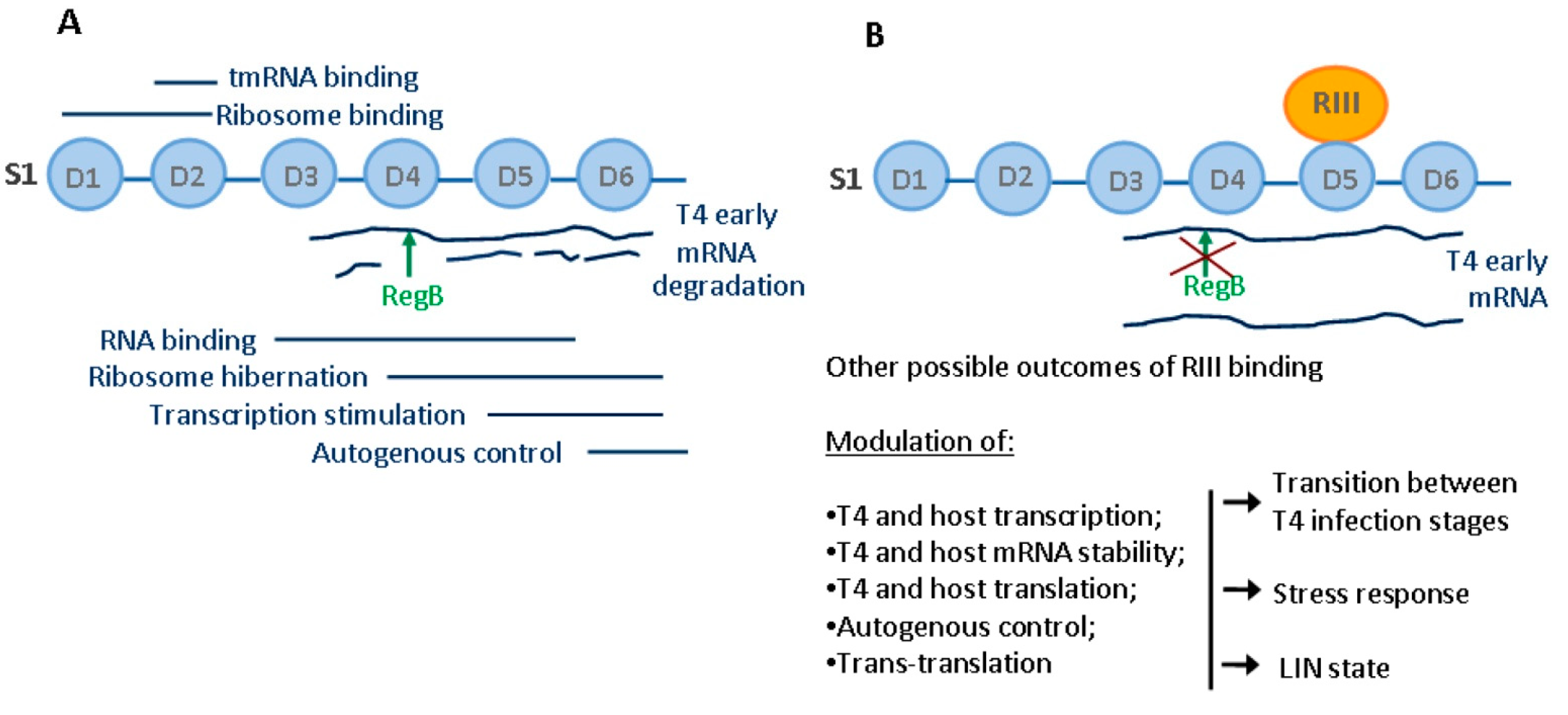Interaction between Phage T4 Protein RIII and Host Ribosomal Protein S1 Inhibits Endoribonuclease RegB Activation
Abstract
1. Introduction
2. Results
2.1. The Recombinant Protein RIII of T4 Co-Purifies with the Host Ribosomal Protein S1 in Stoichiometric Amounts
2.2. The RIII Protein of Bacteriophage T4 Mainly Targets the 5th Domain of S1
2.3. The Intact Ribosomal Protein S1 Is the Best Interaction Partner of RIII In Vivo
2.4. The Protein RIII Inhibits Endoribonuclease RegB Activation by S1
3. Discussion
4. Materials and Methods
4.1. Escherichia coli Strains, Phages, and Plasmid Vectors
4.2. PCR and DNA Cloning
4.3. Overproduction and Purification of the Recombinant Proteins
4.4. Proteomics Analysis
4.5. Pull-Down Assays
4.6. Determination of Interaction Stoichiometry
4.7. Assay of Protein Interactions in a Bacterial Two-Hybrid System
4.8. Construction of T4 Phage Mutants
4.9. Isolation of Total RNA from Infected Cells
4.10. In Vitro Activity Tests of RegB Endoribonuclease
4.11. Primer Extension Analysis of T4 mRNA
4.12. Densitometric Analysis of Gel Images
Supplementary Materials
Author Contributions
Funding
Institutional Review Board Statement
Informed Consent Statement
Data Availability Statement
Conflicts of Interest
References
- Walsh, D.; Mohr, I. Viral subversion of the host protein synthesis machinery. Nat. Rev. Microbiol. 2011, 9, 860–875. [Google Scholar] [CrossRef] [PubMed]
- Dendooven, T.; Van den Bossche, A.; Hendrix, H.; Ceyssens, P.J.; Voet, M.; Bandyra, K.J.; De Maeyer, M.; Aertsen, A.; Noben, J.P.; Hardwick, S.W.; et al. Viral interference of the bacterial RNA metabolism machinery. RNA Biol. 2017, 14, 6–10. [Google Scholar] [CrossRef] [PubMed]
- Chen, Z.; Wang, C.; Feng, X.; Nie, L.; Tang, M.; Zhang, H.; Xiong, Y.; Swisher, S.K.; Srivastava, M.; Chen, J. Interactomes of SARS-CoV-2 and human coronaviruses reveal host factors potentially affecting pathogenesis. EMBO J. 2021, 40, e107776. [Google Scholar] [CrossRef] [PubMed]
- Kazlauskas, D.; Krupovic, M.; Venclovas, Č. The logic of DNA replication in double-stranded DNA viruses: Insights from global analysis of viral genomes. Nucleic Acids Res. 2016, 44, 4551–4564. [Google Scholar] [CrossRef]
- McAllister, W.T.; Raskin, C.A. The phage RNA polymerases are related to DNA polymerases and reverse transcriptases. Mol. Microbiol. 1993, 10, 1–6. [Google Scholar] [CrossRef]
- Morcinek-Orłowska, J.; Zdrojewska, K.; Węgrzyn, A. Bacteriophage-Encoded DNA Polymerases-Beyond the Traditional View of Polymerase Activities. Int. J. Mol. Sci. 2022, 23, 635. [Google Scholar] [CrossRef]
- Jan, E.; Mohr, I.; Walsh, D.A. Cap-to-Tail Guide to mRNA Translation Strategies in Virus-Infected Cells. Annu. Rev. Virol. 2016, 3, 283–307. [Google Scholar] [CrossRef]
- Li, S. Regulation of Ribosomal Proteins on Viral Infection. Cells 2019, 8, 508. [Google Scholar] [CrossRef]
- Mizuno, C.M.; Guyomar, C.; Roux, S.; Lavigne, R.; Rodriguez-Valera, F.; Sullivan, M.B.; Gillet, R.; Forterre, P.; Krupovic, M. Numerous cultivated and uncultivated viruses encode ribosomal proteins. Nat. Commun. 2019, 10, 752. [Google Scholar] [CrossRef]
- Gao, L.; Altae-Tran, H.; Böhning, F.; Makarova, K.S.; Segel, M.; Schmid-Burgk, J.L.; Koob, J.; Wolf, Y.; Koonin, E.V.; Zhang, F. Diverse enzymatic activities mediate antiviral immunity in prokaryotes. Science 2020, 369, 1077–1084. [Google Scholar] [CrossRef]
- Hampton, H.G.; Watson, B.N.J.; Fineran, P.C. The arms race between bacteria and their phage foes. Nature 2020, 577, 327–336. [Google Scholar] [CrossRef] [PubMed]
- Golais, F.; Hollý, J.; Vítkovská, J. Coevolution of bacteria and their viruses. Folia Microbiol. 2013, 58, 177–186. [Google Scholar] [CrossRef] [PubMed]
- Safari, M.S.; Sharifi, M.; Farajnia, S.; Akbari, B.; Karimi Baba Ahmadi, M.; Negahdaripour, M.; Younes, G. The interaction of phages and bacteria: The coevolutionary arms race. Crit. Rev. Biotechnol. 2020, 40, 119–137. [Google Scholar] [CrossRef]
- Hobbs, Z.; Abedon, S.T. Diversity of phage infection types and associated terminology: The problem with ‘Lytic or lysogenic’. FEMS Microbiol. Lett. 2016, 363, fnw047. [Google Scholar] [CrossRef] [PubMed]
- Guttman, B.; Raya, R.; Kutter, E. Basic phage biology. In Bacteriophages: Biology and Application, 1st ed.; Kutter, E., Sulakvelidze, A., Eds.; CRC Press: Boca Raton, FL, USA, 2004; pp. 29–66. [Google Scholar]
- Kutter, E.; Bryan, D.; Ray, G.; Brewster, E.; Blasdel, B.; Guttman, B. From Host to Phage Metabolism: Hot Tales of Phage T4’s Takeover of E. coli. Viruses 2018, 10, 387. [Google Scholar] [CrossRef] [PubMed]
- Koch, T.; Raudonikiene, A.; Wilkens, K.; Rüger, W. Overexpression, purification, and characterization of the ADP-ribosyltransferase (gpAlt) of bacteriophage T4: ADP-ribosylation of E. coli RNA polymerase modulates T4 “early” transcription. Gene Expr. 1995, 4, 253–264. [Google Scholar]
- Hinton, D. Transcriptional control in the prereplicative phase of T4 development. Virol. J. 2010, 7, 289. [Google Scholar] [CrossRef]
- Geiduschek, E.P.; Kassavetis, G.A. Transcription of the T4 late genes. Virol. J. 2010, 7, 288. [Google Scholar] [CrossRef]
- Uzan, M.; Miller, E.S. Post-transcriptional control by bacteriophage T4: mRNA decay and inhibition of translation initiation. Virol. J. 2010, 7, 360. [Google Scholar] [CrossRef]
- Uzan, M.; Favre, R.; Brody, E. A nuclease that cuts specifically in the ribosome-binding site of some T4 mRNAs. Proc. Natl. Acad. Sci. USA 1988, 85, 8895–8899. [Google Scholar] [CrossRef]
- Zajančkauskaite, A.; Truncaite, L.; Strazdaite-Žieliene, Ž.; Nivinskas, R. Involvement of the Escherichia coli endoribonucleases G and E in the secondary processing of RegB-cleaved transcripts of bacteriophage T4. Virology 2008, 375, 342–353. [Google Scholar] [CrossRef] [PubMed][Green Version]
- Durand, S.; Richard, G.; Bontems, F.; Uzan, M. Bacteriophage T4 polynucleotide kinase triggers degradation of mRNAs. Proc. Natl. Acad. Sci. USA 2012, 109, 7073–8707. [Google Scholar] [CrossRef] [PubMed]
- Strazdaitė-Žielienė, Ž.; Zajančkauskaitė, A.; Kalinienė, L.; Meškys, R.; Truncaitė, L. A mutation in the gene for polynucleotide kinase of bacteriophage T4 K10 affects mRNA processing. Arch. Virol. 2014, 159, 327–331. [Google Scholar] [CrossRef] [PubMed]
- Qi, D.; Alawneh, A.M.; Yonesaki, T.; Otsuka, Y. Rapid Degradation of Host mRNAs by Stimulation of RNase E Activity by Srd of Bacteriophage T4. Genetics 2015, 201, 977–987. [Google Scholar] [CrossRef]
- Ruckman, J.; Ringquist, S.; Brody, E.; Gold, L. The bacteriophage T4 regB ribonuclease. Stimulation of the purified enzyme by ribosomal protein S1. J. Biol. Chem. 1994, 269, 26655–26662. [Google Scholar] [CrossRef]
- Subramanian, A.R.; van Duin, J. Exchange of individual ribosomal proteins between ribosomes as studied by heavy isotope-transfer experiments. Mol. Gen. Genet. 1977, 158, 1–9. [Google Scholar] [CrossRef]
- Loveland, A.B.; Korostelev, A.A. Structural dynamics of protein S1 on the 70S ribosome visualized by ensemble cryo-EM. Methods 2018, 137, 55–66. [Google Scholar] [CrossRef]
- Subramanian, A.R. Structure and functions of ribosomal protein S1. Prog. Nucleic Acid Res. Mol. Biol. 1983, 28, 101–142. [Google Scholar]
- Bycroft, M.; Hubbard, T.J.P.; Proctor, M.; Freund, S.M.V.; Murzin, A.G. The Solution Structure of the S1 RNA Binding Domain: A Member of an Ancient Nucleic Acid–Binding. Cell 1997, 88, 235–242. [Google Scholar] [CrossRef]
- Giorginis, S.; Subramanian, A.R. The major ribosome binding site of Escherichia coli ribosomal protein S1 is located in its N-terminal segment. J. Mol. Biol. 1980, 141, 393–408. [Google Scholar] [CrossRef]
- Byrgazov, K.; Manoharadas, S.; Kaberdina, A.C.; Vesper, O.; Moll, I. Direct interaction of the N-terminal domain of ribosomal protein S1 with protein S2 in Escherichia coli. PLoS ONE 2012, 7, e32702. [Google Scholar] [CrossRef] [PubMed]
- Aliprandi, P.; Sizun, C.; Perez, J.; Mareuil, F.; Caputo, S.; Leroy, J.L.; Odaert, B.; Laalami, S.; Uzan, M.; Bontems, F. S1 ribosomal protein functions in translation initiation and ribonuclease RegB activation are mediated by similar RNA-protein interactions: An NMR and SAXS analysis. J. Biol. Chem. 2008, 283, 13289–13301. [Google Scholar] [CrossRef] [PubMed]
- Salah, P.; Bisaglia, M.; Aliprandi, P.; Uzan, M.; Sizun, C.; Bontems, F. Probing the relationship between Gram-negative and Gram-positive S1 proteins by sequence analysis. Nucleic Acids Res. 2009, 37, 5578–5588. [Google Scholar] [CrossRef] [PubMed]
- Duval, M.; Korepanov, A.; Fuchsbauer, O.; Fechter, P.; Haller, A.; Fabbretti, A.; Choulier, L.; Micura, R.; Klaholz, B.P.; Romby, P.; et al. Escherichia coli ribosomal protein S1 unfolds structured mRNAs onto the ribosome for active translation initiation. PLoS Biol. 2013, 11, e1001731. [Google Scholar] [CrossRef]
- Sørensen, M.A.; Fricke, J.; Pedersen, S. Ribosomal protein S1 is required for translation of most, if not all, natural mRNAs in Escherichia coli in vivo. J. Mol. Biol. 1988, 280, 561–569. [Google Scholar] [CrossRef]
- Hajnsdorf, E.; Boni, I.V. Multiple activities of RNA-binding proteins S1 and Hfq. Biochimie 2012, 94, 1544–1553. [Google Scholar] [CrossRef]
- Wahba, A.J.; Miller, M.J.; Niveleau, A.; Landers, T.A.; Carmichael, G.G.; Weber, K.; Hawley, D.A.; Slobin, L.I. Subunit I of G beta replicase and 30 S ribosomal protein S1 of Escherichia coli. Evidence for the identity of the two proteins. J. Biol. Chem. 1974, 249, 3314–3316. [Google Scholar] [CrossRef]
- Chetverin, A.B.; Ugarov, V.I. Chetverina, H.V. Unsolved puzzles of Qβ replicase. Mol. Biol. 2019, 53, 791–801. [Google Scholar] [CrossRef]
- Boni, I.V.; Isaeva, D.M.; Musychenko, M.L.; Tzareva, N.V. Ribosome-messenger recognition: mRNA target sites for ribosomal protein S1. Nucleic Acids Res. 1991, 19, 155–162. [Google Scholar] [CrossRef]
- Wagner, A.; Weise, L.I.; Mutschler, H. In vitro characterisation of the MS2 RNA polymerase complex reveals host factors that modulate emesviral replicase activity. Commun. Biol. 2022, 5, 264. [Google Scholar] [CrossRef]
- Muniyappa, K.; Mythili, E. Phage lambda beta protein, a component of general recombination, is associated with host ribosomal S1 protein. Biochem. Mol. Biol. Int. 1993, 31, 1–11. [Google Scholar] [PubMed]
- Lebars, I.; Hu, R.M.; Lallemand, J.Y.; Uzan, M.; Bontems, F. Role of the substrate conformation and of the S1 protein in the cleavage efficiency of the T4 endoribonuclease RegB. Biol. Chem. 2001, 276, 13264–13272. [Google Scholar] [CrossRef] [PubMed]
- Durand, S.; Richard, G.; Bisaglia, M.; Laalami, S.; Bontems, F.; Uzan, M. Activation of RegB endoribonuclease by S1 ribosomal protein requires an 11 nt conserved sequence. Nucleic Acids Res. 2006, 34, 6549–6560. [Google Scholar] [CrossRef] [PubMed][Green Version]
- Bisaglia, M.; Laalami, S.; Uzan, M.; Bontems, F. Activation of the RegB endoribonuclease by the S1 ribosomal protein is due to cooperation between the S1 four C-terminal modules, in a substrate-dependent manner. J. Biol. Chem. 2003, 278, 15261–15271. [Google Scholar] [CrossRef] [PubMed]
- Demerec, M.; Fano, U. Bacteriophage-resistant mutants in Escherichia coli. Genetics 1945, 30, 119–136. [Google Scholar] [CrossRef]
- Hershey, A.D. Mutation of bacteriophage with respect to type of plaque. Genetics 1946, 31, 620–640. [Google Scholar] [CrossRef]
- Doermann, A.H. Lysis and lysis inhibition with Escherichia coli bacteriophage. J. Bacteriol. 1948, 55, 257–276. [Google Scholar] [CrossRef]
- Abedon, S.T. Look Who‘s Talking: T-Even Phage Lysis Inhibition, the Granddaddy of Virus-Virus Intercellular Communication Research. Viruses 2019, 11, 951. [Google Scholar] [CrossRef]
- Chen, Y.; Young, R. The last r locus unveiled: T4 RIII is a cytoplasmic antiholin. J. Bacteriol. 2016, 198, 2448–2457. [Google Scholar] [CrossRef]
- Golec, P.; Wiczk, A.; Łoś, J.M.; Konopa, G.; Węgrzyn, G.; Łoś, M. Persistence of bacteriophage T4 in a starved Escherichia coli culture: Evidence for the presence of phage subpopulations. J. Gen. Virol. 2011, 92, 997–1003. [Google Scholar] [CrossRef]
- Karimova, G.; Pidoux, J.; Ullmann, A.; Ladant, D. A bacterial two-hybrid system based on a reconstituted signal transduction pathway. Proc. Natl. Acad. Sci. USA 1998, 95, 5752–5756. [Google Scholar] [CrossRef] [PubMed]
- Uzan, M. RNA processing and decay in bacteriophage T4. Prog. Mol. Biol. Transl. Sci. 2009, 85, 43–89. [Google Scholar] [PubMed]
- Sanson, B.; Uzan, M. Dual role of the sequence-specific bacteriophage T4 endoribonuclease RegB. mRNA inactivation and mRNA destabilization. J. Mol. Biol. 1993, 233, 429–446. [Google Scholar] [CrossRef]
- Truncaite, L.; Zajanckauskaite, A.; Arlauskas, A.; Nivinskas, R. Transcription and RNA processing during expression of genes preceding DNA ligase gene 30 in T4-related bacteriophages. Virology 2006, 344, 378–390. [Google Scholar] [CrossRef] [PubMed][Green Version]
- Benzer, S. The elementary units of heredity. In The Chemical Basis of Heredity; McElroy, W.D., Glass, B., Eds.; The John Hopkins Press: Baltimore, MD, USA, 1957; pp. 70–93. [Google Scholar]
- Raudonikiene, A.; Nivinskas, R. The sequence of gene rIII of bacteriophage T4 and its mutants. Gene 1993, 134, 135–136. [Google Scholar] [CrossRef]
- Takeshita, D.; Yamashita, S.; Tomit, K. Molecular insights into replication initiation by Qβ replicase using ribosomal protein S1. Nucleic Acids Res. 2014, 42, 10809–10822. [Google Scholar] [CrossRef]
- Okada, T.; Wower, I.K.; Wower, J.; Zwieb, C.W.; Kimura, M. Contribution of the second OB fold of ribosomal protein S1 from Escherichia coli to the recognition of TmRNA. Biosci. Biotechnol. Biochem. 2004, 68, 2319–2325. [Google Scholar] [CrossRef][Green Version]
- Subramanian, A.R.; Rienhardt, P.; Kimura, M.; Suryanarayana, T. Fragments of ribosomal protein S1 and its mutant form m1-S1. Localization of nucleic-acid-binding domain in the middle region of S1. Eur. J. Biochem. 1981, 119, 245–249. [Google Scholar] [CrossRef]
- Beckert, B.; Turk, M.; Czech, A.; Berninghausen, O.; Beckmann, R.; Ignatova, Z.; Plitzko, J.M.; Wilson, D.N. Structure of a hibernating 100S ribosome reveals an inactive conformation of the ribosomal protein S1. Nat. Microbiol. 2018, 3, 1115–1121. [Google Scholar] [CrossRef]
- Sukhodolets, M.V.; Garges, S.; Adhya, S. Ribosomal protein S1 promotes transcriptional cycling. RNA 2006, 12, 1505–1513. [Google Scholar] [CrossRef]
- Eason, I.R.; Kaur, H.P.; Alexander, K.A.; Sukhodolets, M.V. Growth phase-specific changes in the composition of E. coli transcription complexes. J. Chromatogr. B Analyt. Technol. Biomed. Life Sci. 2019, 1109, 155–165. [Google Scholar] [CrossRef] [PubMed]
- Sukhodolets, M.V.; Garges, S. Interaction of Escherichia coli RNA polymerase with the ribosomal protein S1 and the Sm-like ATPase Hfq. Biochemistry 2003, 42, 8022–8034. [Google Scholar] [CrossRef] [PubMed]
- Boni, I.V.; Artamonova, V.S.; Dreyfus, M. The last RNA-binding repeat of the Escherichia coli ribosomal protein S1 is specifically involved in autogenous control. J. Bacteriol. 2000, 182, 5872–5879. [Google Scholar] [CrossRef] [PubMed][Green Version]
- Sanson, B.; Hu, R.M.; Troitskaya, E.; Mathy, N.; Uzan, M. Endoribonuclease RegB from bacteriophage T4 is necessary for the degradation of early but not middle or late mRNAs. J. Mol. Biol. 2000, 297, 1063–1074. [Google Scholar] [CrossRef]
- Van den Bossche, A.; Hardwick, S.W.; Ceyssens, P.-J.; Hendrix, H.; Voet, M.; Dendooven, T.; Bandyra, K.J.; De Maeyer, M.; Aertsen, A.; Noben, J.-P.; et al. Structural elucidation of a novel mechanism for the bacteriophage-based inhibition of the RNA degradosome. Elife 2016, 5, e16413. [Google Scholar] [CrossRef]
- Miller, E.S.; Kutter, E.; Mosig, G.; Arisaka, F.; Kunisawa, T.; Rüger, W. Bacteriophage T4 genome. Microbiol. Mol. Biol. Rev. 2003, 67, 86–156. [Google Scholar] [CrossRef]
- Ramanculov, E.; Young, R. An ancient player unmasked: T4 rI encodes a t-specific antiholin. Mol. Microbiol. 2001, 41, 575–583. [Google Scholar] [CrossRef]
- Paddison, P.; Abedon, S.T.; Dressman, H.K.; Gailbreath, K.; Tracy, J.; Mosser, E.; Neitzel, J.; Guttman, B.; Kutter, E. The roles of the bacteriophage T4 r genes in lysis inhibition and fine-structure genetics: A new perspective. Genetics 1998, 148, 1539–1550. [Google Scholar] [CrossRef]
- Moussa, S.H.; Kuznetsov, V.; Tran, T.A.T.; Sacchettini, J.C.; Young, R. Protein determinants of phage T4 lysis inhibition. Protein Sci. 2012, 21, 571–582. [Google Scholar] [CrossRef]
- Krieger, I.V.; Kuznetsov, V.; Chang, J.-Y.; Zhang, J.; Moussa, S.H.; Young, R.F.; Sacchettini, J.C. The Structural Basis of T4 Phage Lysis Control: DNA as the Signal for Lysis Inhibition. J. Mol. Biol. 2020, 432, 4623–4636. [Google Scholar] [CrossRef]
- Golec, P.; Karczewska-Golec, J.; Voigt, B.; Albrecht, D.; Schweder, T.; Hecker, M.; Węgrzyn, G.; Łoś, M. Proteomic profiles and kinetics of development of bacteriophage T4 and its rI and rIII mutants in slowly growing Escherichia coli. J. Gen. Virol. 2013, 94, 896–905. [Google Scholar] [CrossRef] [PubMed]
- Driukas, A.; Nivinskas, R. Studies on the expression of genes rIII and 30.9 of bacteriophage T4 in vivo. Biologija 2003, 3, 13–15. [Google Scholar]
- Malys, N.; Nivinskas, R. Non-canonical RNA arrangement in T4-even phages: Accommodated ribosome binding site at the gene 26-25 intercistronic junction. Mol. Microbiol. 2009, 73, 1115–1127. [Google Scholar] [CrossRef] [PubMed]
- Kunisawa, T. Synonymous codon preferences in bacteriophage T4: A distinctive use of transfer RNAs from T4 and from its host Escherichia coli. J. Theor. Biol. 1992, 159, 287–298. [Google Scholar] [CrossRef]
- Tiemann, B.; Depping, R.; Gineikiene, E.; Kaliniene, L.; Nivinskas, R.; Rüger, W. ModA and ModB, two ADP-ribosyltransferase encoded encoded by bacteriophage T4: Catalytic properties. and mutation analysis. J. Bacteriol. 2004, 186, 7262–7272. [Google Scholar] [CrossRef] [PubMed]
- Depping, R.; Lohaus, C.; Meyer, H.E.; Rüger, W. The mono-ADP-ribosyltransferases Alt and ModB of bacteriophage T4: Target proteins identified. Biochem. Biophys. Res. Commun. 2005, 335, 1217–1223. [Google Scholar] [CrossRef]
- Malys, N.; McCarty, J.E.G. Translation initiation: Variations in the mechanism can be anticipated. Cell Mol. Life Sci. 2011, 68, 991–1003. [Google Scholar] [CrossRef]
- Yarchuk, O.; Iost, I.; Dreyfus, M. The relation between translation and mRNA degradation in the lacZ gene. Biochimie 1991, 73, 1533–1541. [Google Scholar] [CrossRef]
- Braun, F.; Le Derout, J.; Régnier, P. Ribosomes inhibit an RNase E cleavage which induces the decay of the rpsO mRNA of Escherichia coli. EMBO J. 1998, 17, 4790–4797. [Google Scholar] [CrossRef]
- Selick, H.E.; Kreuzer, K.N.; Alberts, B.M. The bacteriophage T4 insertion/substitution vector system. A method for introducing site-specific mutations into the virus chromosome. J. Biol. Chem. 1988, 263, 11336–11347. [Google Scholar] [CrossRef]
- Zajanckauskaite, A.; Raudonikiene, A.; Nivinskas, R. Cloning and expression of genes from the genomic region between genes cd and 30 of bacteriophage T4. Gene 1994, 147, 71–76. [Google Scholar] [CrossRef]
- Sanger, F.; Nicklen, S.; Coulson, A.R. DNA sequencing with chain-terminating inhibitors. Proc. Natl. Acad. Sci. USA 1977, 74, 5463–5467. [Google Scholar] [CrossRef] [PubMed]
- Lazar, I., Jr.; Lazar, I., Sr. GelAnalyzer (Version 19.1). 2010. Available online: www.gelanalyzer.com (accessed on 10 May 2022).





| E. coli Strain | Relevant Characteristics | Used for | Source/Reference |
|---|---|---|---|
| DH10B | F– endA1 recA1 galE15 galK16 nupG rpsL ΔlacX74 Φ80lacZΔM15 araD139 Δ(ara,leu)7697 mcrA Δ(mrr-hsdRMS-mcrBC) λ- | Cloning, construction of T4 mutant | Thermo Fisher Scientific |
| BL21 (DE3) | E. coli B F– dcm ompT hsdS(rB– mB–) gal λ(DE3) | Superexpression of cloned genes | Novagen |
| BTH101 | F– cys-99 araD139 galE15 galK16 rpsL1 (StrR) hsdR2 mcrA1 mcrB1 | Experiments in BACTH system; T4 propagation; isolation of total RNA from infected cells | Euromedex/[52] |
| Phage | |||
| T4 wt | Wild-type (T4D+) | Infection of E. coli | A gift from Dr. W.B. Wood |
| T4 ∆rIII | T4 wt carrying deletion of gene rIII. | Infection of E. coli | This study |
| T4 ∆rIII∆regB | T4 wt carrying deletions of genes rIII and regB. | Infection of E. coli | This study |
| Plasmid | |||
| pET21a | ApR; expression vector encoding IPTG-inducible T7 promoter | Cloning | Novagen |
| pET21d | ApR; expression vector encoding IPTG-inducible T7 promoter | Cloning | Novagen |
| pET28a | KmR; expression vector encoding IPTG-inducible T7 promoter | Cloning | Novagen |
| pET16b | ApR; expression vector encoding IPTG-inducible T7 promoter | Cloning | Novagen |
| pKNT25 | KmR; expressing T25 fragment (first 224 aa of CyaA) under control of a lac promoter. | Cloning and negative control of protein–protein interaction | Euromedex/[52] |
| pUT18 | ApR; expressing T18 fragment (225 to 399 aa of CyaA) under control of a lac promoter. | Cloning and negative control of protein–protein interaction | Euromedex/[52] |
| pKT25-zip | KmR; expressing the leucine zipper of GCN4 fused to the T25 fragment under control of the lac promoter. | Positive control of protein–protein interaction | Euromedex/[52] |
| pUT18C-zip | ApR; expressing the leucine zipper of GCN4 fused to the T18 fragment under control of the lac promoter. | Positive control of protein–protein interaction | Euromedex/[52] |
| pJet1.2 blunt | ApR; blunt Cloning vector | Cloning for recombination | Thermo Fisher Scientific |
| pBSPLO+ | ApR; vector designed for T4 homologous recombination | Cloning for recombination | A gift from Dr. K.N. Kreuzer [82] |
| pRA6-2 | carries the 0.43-kb HpaI-BglII T4 DNA fragment with gene 31 | DNA fragment for cloning | [83] |
Publisher’s Note: MDPI stays neutral with regard to jurisdictional claims in published maps and institutional affiliations. |
© 2022 by the authors. Licensee MDPI, Basel, Switzerland. This article is an open access article distributed under the terms and conditions of the Creative Commons Attribution (CC BY) license (https://creativecommons.org/licenses/by/4.0/).
Share and Cite
Juškauskas, A.; Zajančkauskaitė, A.; Meškys, R.; Ger, M.; Kaupinis, A.; Valius, M.; Truncaitė, L. Interaction between Phage T4 Protein RIII and Host Ribosomal Protein S1 Inhibits Endoribonuclease RegB Activation. Int. J. Mol. Sci. 2022, 23, 9483. https://doi.org/10.3390/ijms23169483
Juškauskas A, Zajančkauskaitė A, Meškys R, Ger M, Kaupinis A, Valius M, Truncaitė L. Interaction between Phage T4 Protein RIII and Host Ribosomal Protein S1 Inhibits Endoribonuclease RegB Activation. International Journal of Molecular Sciences. 2022; 23(16):9483. https://doi.org/10.3390/ijms23169483
Chicago/Turabian StyleJuškauskas, Augustinas, Aurelija Zajančkauskaitė, Rolandas Meškys, Marija Ger, Algirdas Kaupinis, Mindaugas Valius, and Lidija Truncaitė. 2022. "Interaction between Phage T4 Protein RIII and Host Ribosomal Protein S1 Inhibits Endoribonuclease RegB Activation" International Journal of Molecular Sciences 23, no. 16: 9483. https://doi.org/10.3390/ijms23169483
APA StyleJuškauskas, A., Zajančkauskaitė, A., Meškys, R., Ger, M., Kaupinis, A., Valius, M., & Truncaitė, L. (2022). Interaction between Phage T4 Protein RIII and Host Ribosomal Protein S1 Inhibits Endoribonuclease RegB Activation. International Journal of Molecular Sciences, 23(16), 9483. https://doi.org/10.3390/ijms23169483







